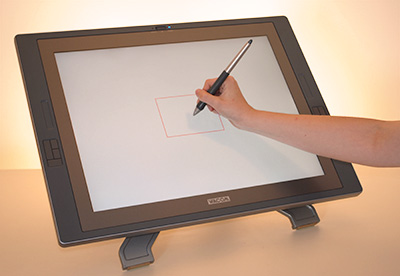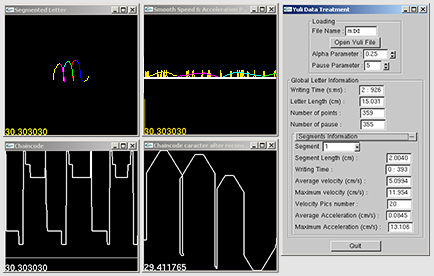Graphomotor activities
Graphomotor skills (drawing and writing) can be studied in a variety of levels, ranging from the most elementary (analysis of graphic movements) to the most advanced (analysis of symbolic content). One of the less frequent ways of studying graphomotor skills is via graphic syntax, i.e., the analysis of the rules of sequencing graphic segments. Our research bears on all of these levels.
In terms of writing, our goal is to use modern technology – specifically, a drawing board with digital data capture – to contribute to improve our understanding of how writing is learned. We are particularly interested in the role of the availability of visual information on writing movement (Chartrel & Vinter, 2006), as well as the impact of spatio-temporal constraints on the writing gestures of very young children (Chartrel & Vinter, 2008). Further, we are studying the role in learning to write of various pre-requisites, such as the ability to visually recognize cursive letters, the children’s ability to recognize letters based on the proprioceptive movements associated with the letters themselves (Vinter & Chartrel, 2008). Finally, we have compared the effectiveness of visual-, motor- and visual/motor-learning as means of teaching children to write cursive letters. This work demonstrated the importance of dynamic visual information in cursive-letter writing (Vinter & Chartrel, 2010).
In the area of drawing, the link between graphic syntax and children’s cognitive activity is at the heart of our research program. We have developed a number of variations of the paradigmatic experimental design in which the children copy complex series of figures. These variations involve priming situations, completion tasks, copy-from-memory tasks, etc. Based on these experiments we have shown how the analysis of graphic syntax sheds light on the cognitive mechanisms that allow children to segment complex visual figures (Vinter & Marot, 2007). We have recently published an overview of this work on graphic syntax (Vinter, Picard, & Fernandes, 2008). Finally, we anticipate the study of the symbolic content of drawings through work with blind or sight-impaired children. This research is application-oriented and involves the collaboration with a publishing house specialized in tactilely illustrated books for blind children or for children with severe sight problems (LDQR: Les Doigts Qui Rêvent, http://www.ldqr.org/).
 |
 |
| digitizing tablet |
graphomotor treatment |